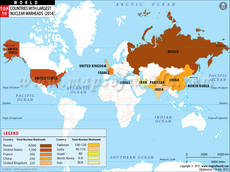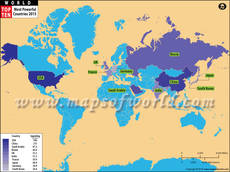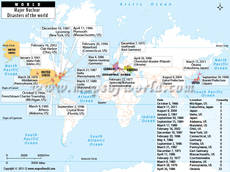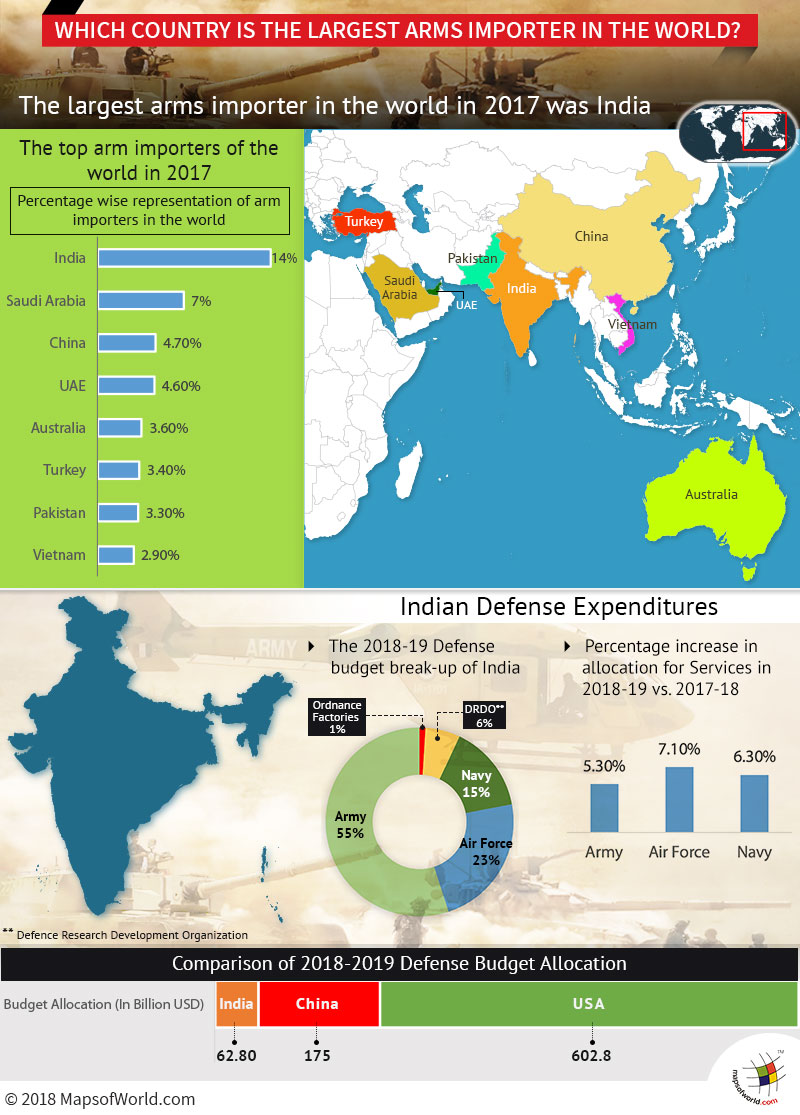Who is the World’s largest arms importer
The largest arms importer in the world in 2017 was India.
China maintains the largest standing military in the world (2.15 million), followed by India (1.39 million), the United States (1.34 million), North Korea (1.19 million), and Russia (0.83 million).
The top importers of arms in 2017:
| Country | % of total arms imports |
| India | 14.0 |
| Saudi Arabia | 7.0 |
| China | 4.7 |
| UAE | 4.6 |
| Australia | 3.6 |
| Turkey | 3.4 |
| Pakistan | 3.3 |
| Vietnam | 2.9 |
India’s Defense Modernization
India imports 14% of the total global arms. Between 2013-17, India’s share of the global arms imports was 12%, and India’s defense imports have been steadily rising. India’s defense imports increased by 24% during 2013-17 vs 2008-12.
In the 2018-19 Budget, India allocated $62.8 billion to the Ministry of Defense marking an overall increase of 7.81% over the previous year. $43.4 billion earmarked for defense procurement and related expenses.
The 2018-19 Defense budget break-up:
Army – 55%
Air Force – 23%
Navy – 15%
Defense Research Development Organization (DRDO) – 6%
Ordnance Factories – 1%
The percentage increase in allocation for Services in 2018-19 vs 2017-18:
Army – 5.3%
Air Force – 7.1%
Navy – 6.3%
Despite India being the world’s biggest importer of arms, its total defense budget is only 1.58% of the GDP, its lowest since the 1962 war with China. China spends 3% of its GDP on defense. China’s 2018-19 Budget is $175 billion vs. India’s $62.80 billion. The U.S. Budget stands at $602.8 billion.
India has traditionally relied on arms imports to meet its defense needs. The majority of defense arms imported have come from Russia, and the former Soviet Union. Between 2013-17, 62% of India’s total arms imports came from Russia.
In the 90s, India began the process of defense modernization and proceeded to diversify its arms supplying nations. The biggest addition has been the United States, which now stands as India’s second largest arms supplying nation, having increased its share by 557% during 2013-17 from 2008-12.
The U.S. has been lobbying to sell Lockheed Martin’s F-16 single-engine fighters and Boeing’s F-18A Super Hornets to India.
In 2009, India placed an order on Boeing to supply eight of its P8I long-range maritime reconnaissance and anti-submarine Aircraft. In 2011, India ordered 10 Boeing C-17 Globemaster III airlifters. India has already ordered 22 AH-64E Apache attack helicopters and 15 CH-47F Chinook heavy-lift helicopters.
India is in advanced negotiations with Russia for importing and joint production of the Fifth Generation Fighter Aircraft (FGFA) based on the Sukhoi PAK-FA (T-50). India plans to introduce 250 fighters, subject to negotiations underway between the two countries. India is in the process of finalizing an order for five systems of S-400 air defense missile systems from Russia.
The other countries that have increased exports are France and Israel. India has recently placed an order for 36 Rafael twin-engine multi-role fighter aircraft from Dassault of France, with the possibility of further orders in future. The French company DCNS is assisting India in manufacturing the Scorpene class submarines, six of which have been ordered. India is in the process of inviting bids for the next phase of expansion of its submarine fleet.
Israel is the largest supplier of armed and unarmed drones to India. Recently, Israel has supplied Long Range Surface to Air Missile Systems (Barak 8) jointly developed between IAI of Israel and India.
How is India ahead of China in defense imports?
India has fought three wars with Pakistan (1965, 1971 and 1999) and one with China (1962). It faces border disputes with both countries, and the line of control with both Pakistan and China remains tense.
All three countries have been spending large amounts in defense acquisition. Pakistan spends 3.5% of its GDP and China 3% compared to India’s 1.58%. China has initiated the process of modernization through the domestic military development and from the 90s itself invested heavily on defense R&D.
India and Pakistan have continued to rely on defense imports for modernizing their respective militaries. Although in recent years, India has been pushing to increase focus on the domestic development of arms, it will take another decade for India to bring down its military imports significantly.
China’s heavy investment in defense R&D over the years has paid off. Its reliance on international arms has come down, and it is now emerging as a top-level defense exporter. It is already the biggest supplier of arms to Myanmar and Bangladesh, and with its latest 5th generation Fighter aircraft J-20, it hopes to begin competing with traditional export leaders like the US and Russia for a bigger slice of the international arms market.
The Top 15 exporters of arms in 2016:
| Company | Country | US$ (millions) |
| Lockheed Martin Corp | The United States | 40,830 |
| Boeing | The United States | 29,510 |
| Raytheon | The United States | 22,910 |
| BAE Systems | The United Kingdom | 22,790 |
| Northrop Grumman Corp | The United States | 21,400 |
| General Dynamics Corp | The United States | 19,230 |
| Airbus Group | Trans-European | 12,520 |
| BAE Systems Inc. (BAE UK) | The United States | 9,300 |
| L3 Communications | The United States | 8,890 |
| Leonardo | Italy | 8,500 |
| Thales | France | 8,170 |
| United Technologies Corp | The United States | 6,870 |
| Huntington Ingalls Industries | The United States | 6,720 |
| United Aircraft Corp. | Russia | 5,160 |
| Bechtel Corp. | The United States | 4,920 |
Visit the following to learn more about Weapons with World Countries:
Related Maps:





